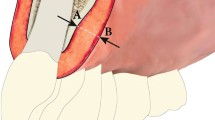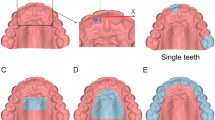Abstract
Purpose
The objectives of this study were to extract a computational three-dimensional (3D) soft palate model from a set of magnetic resonance imaging (MRI) data and to identify an approach that generates a patient-specific model in a computerized visual platform.
Methods
Multiple MRI slices of the head and neck region of a young, non-overweight Caucasian male volunteer were taken in the supine position with a passive oral appliance in place. The DICOM (Digital Imaging and Communications) MRI slices were registered into a high-resolution volumetric data set for manually segmentation to generate a surface mesh and, with additional editing, a volume mesh. For biomechanical dynamic simulation and for physical simulation of the anatomical structures, the volume mesh format and multiple landmarks of each muscle were imported into ArtiSynth, a 3D biomechanical modeling toolkit.
Results
The segmented soft palate complex consisted of five groups of muscles: levator veli palatini, tensor veli palatini, palatoglossus, palatopharyngeous and musculus uvulae. The palatine tonsil between the pharyngopalatine and glossopalatine arches was included in the segmentation.
Conclusions
The same procedure was used to build up a generic reference model of the dentition, tongue, mandible and airway from a mixture of medical records (CT and dental casts) of the same subject. This manual segmentation method eliminated the common errors that occur from an automatic segmentation although it was more time-consuming. It remains a fundamental process for analyzing the dynamic interaction between anatomical components in the oral, pharyngeal, and laryngeal areas.






Similar content being viewed by others
References
Kyung SH, Park YC, Pae EK (2005) Obstructive sleep apnea patients with the oral appliance experience pharyngeal size and shape changes in three dimensions. Angle Orthod 75:15–22
Susarla SM, Abramson ZR, Dodson TB, Kaban LB (2010) Cephalometric measurement of upper airway length correlates with the presence and severity of obstructive sleep apnea. J Oral Maxillofac Surg 68:2846–2855
Tsuiki S, Ryan CF, Lowe AA, Inoue Y (2007) Functional contribution of mandibular advancement to awake upper airway patency in obstructive sleep apnea. Sleep Breath 11:245–251. doi:10.1007/s11325-007-0119-9
Lee CH, Kim JW, Lee HJ, Yun PY, Kim DY, Seo BS, Yoon IY, Mo JH (2009) An investigation of upper airway changes associated with mandibular advancement device using sleep videofluoroscopy in patients with obstructive sleep apnea. Arch Otolaryngol Head Neck Surg 135:910–914
Lee RW, Sutherland K, Chan AS, Zeng B, Grunstein RR, Darendeliler MA, Schwab RJ, Cistulli PA (2010) Relationship between surface facial dimensions and upper airway structures in obstructive sleep apnea. Sleep 33:1249–1254
Schwab RJ, Pasirstein M, Pierson R, Mackley A, Hachadoorian R, Arens R, Maislin G, Pack AI (2003) Identification of upper airway anatomic risk factors for obstructive sleep apnea with volumetric magnetic resonance imaging. Am J Respir Crit Care Med 168:522–530
Welch KC, Foster GD, Ritter CT, Wadden TA, Arens R, Maislin G, Schwab RJ (2002) A novel volumetric magnetic resonance imaging paradigm to study upper airway anatomy. Sleep 25:532–542
Stuck BA, Maurer JT (2008) Airway evaluation in obstructive sleep apnea. Sleep Med Rev 12:411–436
Kountakis SE, Önerci M (2007) Rhinologic and sleep apnea surgical techniques. Springer, Berlin, pp 265–272
Kane AA, Butman JA, Mullick R, Skopec M, Choyke P (2002) A new method for the study of velopharyngeal function using gated magnetic resonance imaging. Plast Reconstr Surg 109:472–481
Zhang XY, Yang X, Hua H, Chen JJ (2009) Comparison of MRI fast SPGR single slice scan and continuous dynamic scan in patients with obstructive sleep apnea–hypopnea syndrome. Eur J Radiol 71:17–21
Ciscar MA, Juan G, Martinez V, Ramon M, Lloret T, Minguez J, Armengot M, Marin J, Basterra J (2001) Magnetic resonance imaging of the pharynx in OSA patients and healthy subjects. Eur Respir J 17:79–86
Ozgur F, Tuncbilek G, Cila A (2000) Evaluation of velopharyngeal insufficiency with magnetic resonance imaging and nasoendoscopy. Ann Plast Surg 44:8–13
McGowan JC 3rd, Hatabu H, Yousem DM, Randall P, Kressel HY (1992) Evaluation of soft palate function with MRI: application to the cleft palate patient. J Comput Assist Tomogr 16:877–882
Arens R, McDonough JM, Costarino AT, Mahboubi S, Tayag-Kier CE, Maislin G, Schwab RJ, Pack AI (2001) Magnetic resonance imaging of the upper airway structure of children with obstructive sleep apnea syndrome. Am J Respir Crit Care Med 164:698–703
Sekosan M, Zakkar M, Wenig BL, Olopade CO, Rubinstein I (1996) Inflammation in the uvula mucosa of patients with obstructive sleep apnea. Laryngoscope 106:1018–1020
Hamans EP, Van Marck EA, De Backer WA, Creten W, Van de Heyning PH (2000) Morphometric analysis of the uvula in patients with sleep-related breathing disorders. Eur Arch Otorhinolaryngol 257:232–236
Ryan CF, Lowe AA, Li D, Fleetham JA (1991) Magnetic resonance imaging of the upper airway in obstructive sleep apnea before and after chronic nasal continuous positive airway pressure therapy. Am Rev Respir Dis 144:939–944
Fels S, Bilston L (2010) Dynamic modelling of the oral, pharyngeal and laryngeal complex for biomedical applications. Comput Methods Biomech Biomed Eng 13:441–442
Mylavarapu G, Murugappan S, Mihaescu M, Kalra M, Khosla S, Gutmark E (2009) Validation of computational fluid dynamics methodology used for human upper airway flow simulations. J Biomech 42:1553–1559
Drake RL, Vogl W, Mitchell AWM (2005) Gray’s anatomy for students. Elsevier/Churchill Livingstone, London, p 756
Mafee MF, Valvassori GE, Becker M (2005) Imaging of the head and neck. Thieme, Stuttgart, pp 682–728
Carpi F, De Rossi D (2007) Bioinspired actuation of the eyeballs of an android robotic face: concept and preliminary investigations. Bioinspir Biomim 2:S50–S63
Pioggia G, Igliozzi R, Ferro M, Ahluwalia A, Muratori F, De Rossi D (2005) An android for enhancing social skills and emotion recognition in people with autism. IEEE Trans Neural Syst Rehabil Eng 13:507–515
Acknowledgments
This study is supported by Natural Sciences and Engineering Research Council of Canada (NSERC) and Vancouver Coastal Health Research Institute (VCHRI).
Conflict of interest
The authors declare that they have no conflict of interest.
Author information
Authors and Affiliations
Corresponding author
Rights and permissions
About this article
Cite this article
Chen, H., Fels, S., Pang, T. et al. Three-dimensional reconstruction of soft palate modeling from subject-specific magnetic resonance imaging data. Sleep Breath 16, 1113–1119 (2012). https://doi.org/10.1007/s11325-011-0610-1
Received:
Revised:
Accepted:
Published:
Issue Date:
DOI: https://doi.org/10.1007/s11325-011-0610-1




